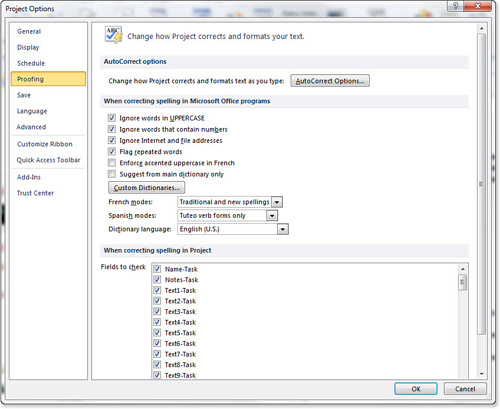Schedule Alerts Options
The Schedule Alerts options (see Figure 6)
enable you to turn task schedule warnings and task schedule suggestions
on and off. More experienced users of Project often find these alerts
obvious and distracting.

Calculation
The Calculation section enables you to select
whether Project recalculates after every change you make, or only when
you specify—typically, to turn on Calculate Project after each edit,
which is the default.
However, if you choose Manual, you can click the
Calculate Project button on the Project tab. This applies not only to
the scheduling of your project, but also to the status as compared to
the planned estimates (such as how much you are behind or ahead of
schedule). The Manual option can be useful on large projects when you
are making updates to the status and want to prevent calculations from
occurring until you have entered all the data. This speeds up your
entry process and prevents pop-up warnings from showing until you are
ready to review the changes. In addition, the Manual option is
effective when you are working on multiple projects that have links
established between them, and you are making a lot of changes in one of
them. It will speed up your editing process, but keep in mind that
links will not be updated between the projects until you manually
calculate.
Calculation Options
The calculation options for this project section
provides a few more options. Checking the box next to Updating Task
Status Updates Resource Status automatically updates the task and
resource status together when either is updated. For example, if you
update a task’s percent complete to 50%, the % Work Complete field is
automatically calculated to reflect that task’s percent effort complete
(50%). The same methodology applies if you update the resource status;
Project automatically updates the task status.
The “Inserted Projects are calculated like Summary
tasks” option pertains to whether data is rolled up to a single task in
your receiving project schedule. The concepts and usage of multiple
project schedules will be covered in more detail later.
Using the “Actual costs are always calculated by
Project” option can be a difficult decision to make. When Project
calculates actual costs, you cannot enter a cost that differs from the
costs specified in the resource rates. You could, however, use a custom
field for those occasions. If you choose to enter actual costs
manually, you can then choose to allow Project to spread those costs up
to the status date. This is more appealing if a task has not been
updated for months. However, if the actual cost incurred represents an
invoice, for example, it might not make any sense to spread the costs.
Finally, the Default Fixed-Cost Accrual can be set to Start, Finish, or Prorated.
Proofing Tab
Under the Proofing tab, you designate which fields you want Project to spell-check automatically (see Figure 7). By default, everything is selected to spell-check. Exceptions are defined with the check boxes on the right.
